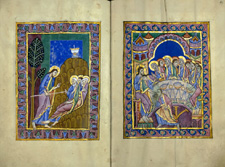Image
© Hildesheim, St Godehard |
THE LAST SUPPER
John 13:21-27
The last supper takes place in an arched space, supported by four turrets.
The disciples sit on a raised semicircular table, with Christ on a seat
of honour on the far left. As Judas receives the sop, a minute devil enters
his mouth at the same time. John rests his head on Christ’s bosom
while the other disciples, in an animated but formulaic manner, either
listen to Christ or talk to each other. The meal is, once again, fish
and bread, served on the smart tablecloth (see
p36)
Jesus is saying ‘Verily I say unto you, that one of you shall betray
me. . The disciples looked one to another, doubting of whom he spake.
He lying on Jesus’ breast saith unto him, Lord, who is it? Jesus
answered, He it is, to whom I shall give a sop, when I have dipped it.
And when he had dipped the sop, he gave it to Judas Iscariot. And after
the sop, Satan entered into him’ (John 13:21-27). At the same time,
he looks directly at Peter, about to explain Peter’s denial to him.
The scene is about betrayal and denial, not the institution of the eucharist:
there is not even any wine on the table. In the Bohemian Coronation Gospels
(Prague, University Library, MS. XIV.A 13, f38v) bowls with stems like
those in the St Albans Psalter are used for both fish and wine, but in
other depictions cups or chalices are generally part of the meal.
Byzantine sources generally show a rounded table, Christ and Judas on
opposite sides, with Judas reaching out to share a dish with Christ (Matthew
26:23). The St Albans artist clearly knew this formula because of the
rounded table, and the disciple on the right is the only one dipping into
a bowl. However, in western scenes, Judas steps forward to receive the
sop, and in several of them a black bird enters Judas’ mouth. A
depiction of the devil himself in this scene is rarer, found in manuscripts
from Salzburg (New York, Pierpont Morgan, MS. 780, f27v) (AP,
59-60, pl 111).
Quire 3.
Thread or stitch holes for protective curtain

Click
to enlarge
|
![]()